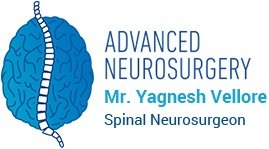Disc Prolapse
The function of the intervertebral disc is to permit stable motion of the spine while supporting and distributing loads under movement. It acts as a shock-absorber.
It has 2 parts: outer annulus and inner nucleus. Annulus fibrosus: multi-laminated ligament that encompasses the periphery of the disc space and attached to end plate cartilage of vertebrae. Blends centrally with nucleus pulposus, the central portion of the disc.
Nomenclature
- Annular tear or annular fissure: separation between annular fibers or avulsion from vertebra
- Degeneration: dessication, fibrosis, narrowing of disc space, diffuse bulging of annulus, osteophytes (bone spurs) : usually age related/ wear and tear
- Disc bulge: generalized displacement of disc material beyond peripheral limits of disc space
- Disc herniation: localized displacement of disc material beyond the limits of disc space
Sub categorized as:
- Focal: less than 25% of disc circumference
- Broad based: the fragment does not have a neck that is narrower than the fragment
- Extrusion: the fragment has a neck that is narrower than the fragment, but still attached to nucleus
- Sequestration: the fragment has lost continuity with the disc of origin ( free disc fragment)
- Schmorl’s node: disc herniated into vertebral body

